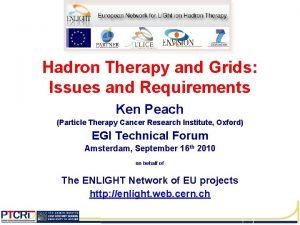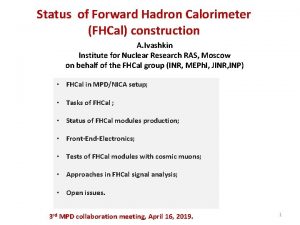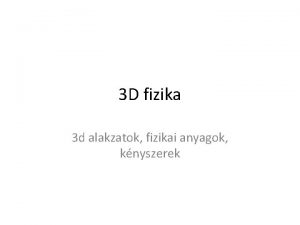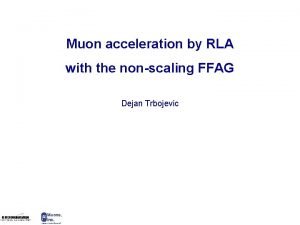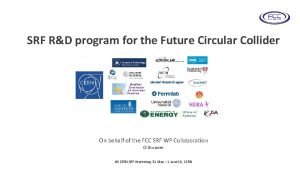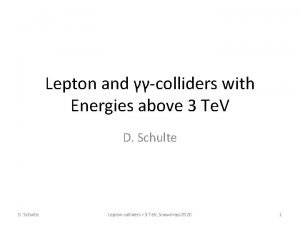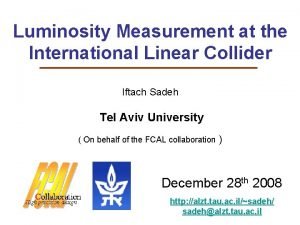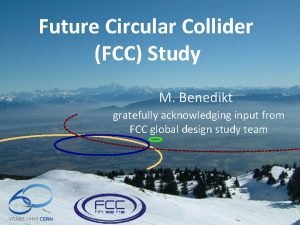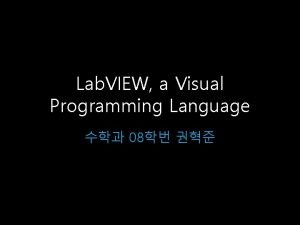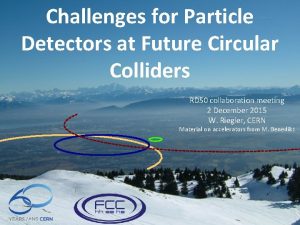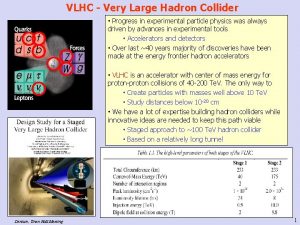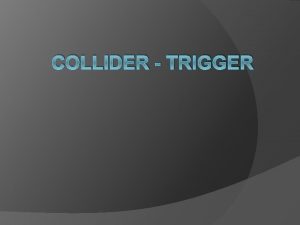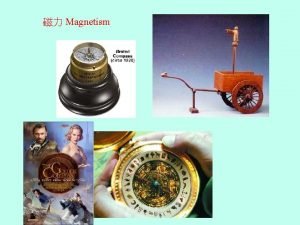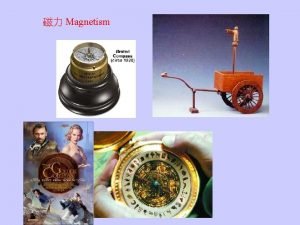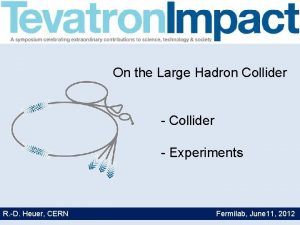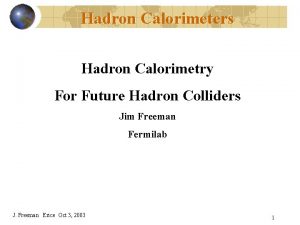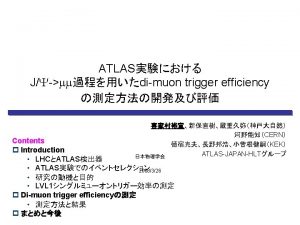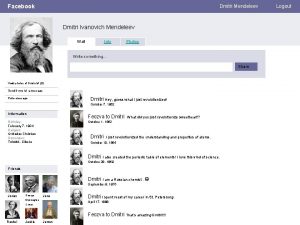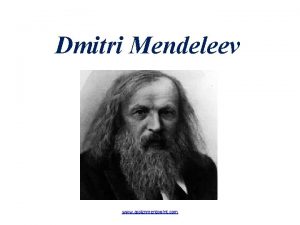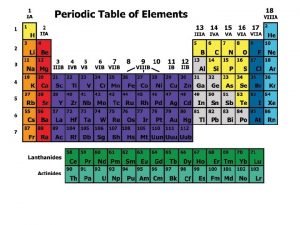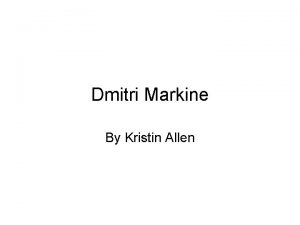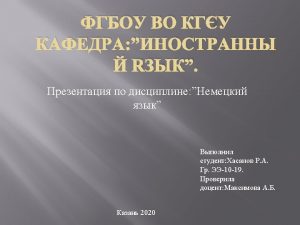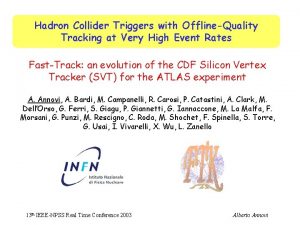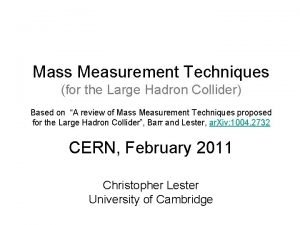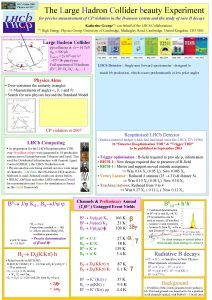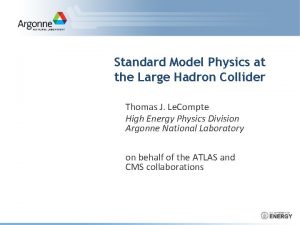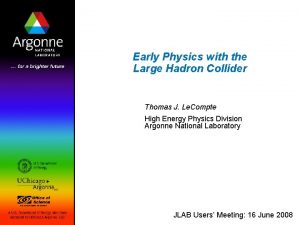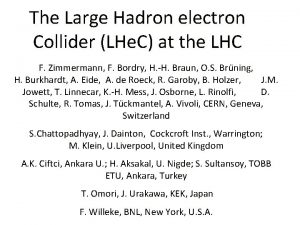VLHC Experiments Overview Very Large Hadron Collider Dmitri




















- Slides: 20

VLHC Experiments: Overview Very Large Hadron Collider Dmitri Denisov Fermilab SLHC/VLHC Workshop Fermilab, October 2003 Outline: Energy frontier Properties of interactions at 100 Te. V What we would like to measure? Accelerator/detector interface Detectors for 100 Te. V R&D plans SLHC/VLHC Workshop, Fermilab 2003 Dmitri Denisov

Energy Frontier · · Tevatron is progressing with delivering world highest energy collisions of 2 Te. V to CDF and D 0 experiments u “Top factory” In a few years LHC will come on-line with 14 Te. V center of mass energy u “Higgs factory” Progress in high energy physics has always been correlated with increase in energy of accelerators/colliders u Higher mass objects could be created u Smaller distances could be studied Next “natural” step is ~100 Te. V center of mass energy u How can we reach such energy? u Can we build detectors for such a machine? SLHC/VLHC Workshop, Fermilab 2003 Dmitri Denisov

Available Literature · There are plenty of documented studies available u Eloisatron studies book u Snowmass 1996 and 2001 reports u VLHC 2001 Design Study report s http: //www. vlhc. org u LHC detectors design reports u SSC detectors design reports s · x 2 in energy only… Experience with running Tevatron and LHC detectors SLHC/VLHC Workshop, Fermilab 2003 Dmitri Denisov

Properties of (soft) pp Interactions · Most results are for 100 Te. V center of mass energy · Increase in total and inelastic cross sections is small u Less then x 2 in comparison with Tevatron u Less then ~30% in comparison with LHC · Values at 100 Te. V u u Total s ~ 150 mb Inelastic s ~100 mb SLHC/VLHC Workshop, Fermilab 2003 Dmitri Denisov

Charged Particles Multiplicities · Number of charged particles produced in 100 Te. V collision is similar to Tevatron/LHC energies u Average number is ~102 particles per interaction u Most particles are concentrated in the central rapidity “platou” region · Important to remember u Distribution of number of particles per interaction is non-Gausian s there is long tail into high multiplicity region SLHC/VLHC Workshop, Fermilab 2003 Dmitri Denisov

Particles Pt Distribution · Most of the particles produced at 100 Te. V are soft u Average Pt of the particle is ~0. 6 Ge. V · This feature might be useful to reduce occupancies in the central region where most high mass objects will decay to u Clean soft charged tracks in the forward region using solenoidal field · Pythia We assume that soft processes simulation is valid from 2 Te. V to 100 Te. V jump u Cosmic rays cross section measurements confirm this assumption SLHC/VLHC Workshop, Fermilab 2003 Dmitri Denisov

Radiation Doses in Central Tracker · · · Radiation doses at high energy/high luminosity colliders are high enough to affect properties of the materials used for detectors construction Mostly affected areas are u Central tracker u Calorimetry in shower maximum u Close to beam pipe elements- see N. Mokhov talk on Saturday As expected from total cross section and Pt spectrum radiation doses in the central region are practically independent of center of mass energy and linear function of luminosity u For central tracker typical dose at 10 cm radius at 1034 cm-2 sec-1 luminosity is ~5 -10 Mrad per year SLHC/VLHC Workshop, Fermilab 2003 Dmitri Denisov

Radiation Doses in Calorimetry · Doses in the shower maximum are reasonable (~ 0. 1 Mrad/year) in the central region, but raise sharply in the forward region u All energy is going in the forward direction · Good eta coverage needed for many studies (missing Et determination) sets hard requirements on the forward calorimetry u ~Grad/year SLHC/VLHC Workshop, Fermilab 2003 Dmitri Denisov

What We Would Like to Measure? · · · Because there is no specific physics process to be studied general purpose detector(s) is a must for an energy frontier machine u Two general detectors sounds like reasonable minimal approach s Verification of the results obtained in very complex experimental and analysis conditions s Competition In order to optimize detector design usually set of benchmark processes are used u Top detection u W mass resolution u Higgs/SUSY discovery u Others which depends upon “hot topics” at the design stage Final design is a compromise between different requirements u Larger tracking volume has advantages for tracking and B physics, but adds material between calorimeter and makes calorimeter less hermetic and more expensive SLHC/VLHC Workshop, Fermilab 2003 Dmitri Denisov

What We Would Like to Measure - Continue · In order to discover top quark both CDF and D 0 had to detect: u Leptons (e/m) u Jets u Tag b-quarks (associated lepton, displaced vertex) u Neutrinos (missing Et) · We need u u u · tracker (e/m, vertex) calorimeter (jets, missing Et) muon system Basically we are measuring all stable (lifetime more ~ size of the detector) known particles SLHC/VLHC Workshop, Fermilab 2003 Dmitri Denisov

Major Accelerator/Detector Interface Parameters - 1 · · Interaction region sizes u Transverse plane s A few microns in diameter – As a point for precision tracking – For short lived particles detection u Longitudinal axis s Longer – Easier to separate multiple interactions – Lower local occupancies and radiation doses s Shorter – smaller (cheaper) detectors – better missing Et resolution From Snowmass and other studies number of s ~ 10 cm came as baseline number u Reasonable from the accelerator stand point SLHC/VLHC Workshop, Fermilab 2003 Dmitri Denisov

Major Accelerator/Detector Interface Parameters - 2 · Bunch spacing time u Shorter bunch spacing reduce number of interactions per crossing s s u Natural limit s s u · Events pileup reduction Complicates detectors and electronics (detector size)/c ~20 ns (LHC’s choice) DC beam? Very important u u Beam halo Other accelerator induced “backgrounds” s s Beam aborts He from the tunnel SLHC/VLHC Workshop, Fermilab 2003 “Simulation” of large multiplicity crossing… Dmitri Denisov

General Purpose Detector · General purpose colliding detector design has been pretty stable over last 10 -15 years u Tracking in the central solenoid field with precision vertexing u Hermetic electro-magnetic and hadron calorimetry with fine space segmentation and good rapidity coverage u Large acceptance muon system with good triggering and tracking capabilities SMT SLHC/VLHC Workshop, Fermilab 2003 Dmitri Denisov

Central Tracker · In order to preserve tracker momentum resolution sp/p ~ Increase detector lever arm (L) - cost Increase magnetic field (B) – at the limit Improve coordinate accuracy of detectors sdet to a few micron level · Major problem for a VLHC tracker is to keep momentum resolution at reasonable level for high pt tracks u Give up momentum measurement a’la Run I Tevatron D 0 detector? SLHC/VLHC Workshop, Fermilab 2003 Dmitri Denisov

Calorimetry - 1 · · Shower depth is ~ln. E u Minor size increase in comparison with LHC Energy resolution: u Electro-magnetic: ~15%/ E, 0. 5% at 1 Te. V u Hadron ~50%/ E, 2% at 1 Te. V Calorimetry gets very precise at high energy! Issue u Events pile up s ~50 Ge. V/jet cone at L=1034 cm-2 sec-1 s Background energy fluctuates and luminosity dependent SLHC/VLHC Workshop, Fermilab 2003 Dmitri Denisov

Calorimetry - 2 · Main specifications for VLHC calorimetry u Radiation hard: ~5 Mrad in the central region and ~10 Grad in the forward region u Small constant term, stable, easy to calibrate u Thick – missing Et, energy resolution u Fast – signal collection time below bunch spacing · Multiple options available u Scintillation based calorimetry u LAr u Crystals u High density gas calorimetry Calorimetry looks OK for luminosity of 1034 cm-2 sec– 1, but not many choices for 1035 cm-2 sec– 1 SLHC/VLHC Workshop, Fermilab 2003 Dmitri Denisov

Detection of Muons - 1 · High energy muons are important for search of heavy objects and low energy muons for t, b quarks tagging · Muon detectors are BIG! · Radiation damage is less of a problem for muon detectors u · but doses especially from accelerator and neutrons have to be carefully estimated High energy muons start to irradiate (em showers) and loose more energy due to radiation losses then due to ionization at a few hundred Ge. V u Creates backgrounds in muon tracking detectors and requires corrections for momentum measurements SLHC/VLHC Workshop, Fermilab 2003 Dmitri Denisov

Detection of Muons - 2 · Momentum resolution is limited by factors similar to the central tracker sp/p ~ u Design SDC (SSC) muon system resolution is ~ 10% at pt ~ 1 Te. V/c · Precision measurement of very high energy muons is a challenging task SLHC/VLHC Workshop, Fermilab 2003 Dmitri Denisov

Issues for Studies – VLHC Detectors · · · Radiation hard detectors u Central tracking and calorimetry Very high precision tracking to measure muon momentum in the range 1 Te. V to 10 Te. V with a few % resolution u Field? Size? Accuracy? Effect of events overlap on final states recognition u Handling 5 Te. V per trigger tower from min_bias overlaps? The only way to reduce number of events per crossing is smaller bunch spacing. Can we build detectors/electronics which will resolve collisions a few ns apart u Begining of one shower is in the em calorimeter while hadron calorimeter still sees remnants of the shower from previous collision? Reduction in cost of the detectors, trigger and DAQ systems u Can design detectors with slightly worse parameters, but cheaper with less construction time? For many years we did not see new principles of particle detection. u Need reasonable level of R&D for the new methods of particles detection, however strange they look from the first glance SLHC/VLHC Workshop, Fermilab 2003 Dmitri Denisov

VLHC Detectors Summary · VLHC general purpose detector design will need u · · Tracking in magnetic field, hermetic calorimetry, and muon system Radiation doses in the central rapidity region increase slowly with collider energy and linearly with luminosity Detectors similar to SSC/LHC could be used to study 100 Te. V collisions at luminosity ~1034 cm-2 sec-1 u Measuring momentum of high pt tracks is a challenge · Luminosities well above 1034 cm-2 sec-1 create serious experimental problems Radiation load u Events pileup Hadron collider is the only currently viable road to the energy frontier, 100 Te. V VLHC will provide opportunity u To create new particles in the 10 Te. V mass range u To “look” at distances of ~10 -20 cm u · SLHC/VLHC Workshop, Fermilab 2003 Dmitri Denisov
 Hadron collider
Hadron collider Hadron collider
Hadron collider Vlhc
Vlhc Multiplication of scientific notation
Multiplication of scientific notation Hadron
Hadron Hadron
Hadron Hadron calorimeter
Hadron calorimeter Unity sphere collider
Unity sphere collider Muon collider
Muon collider Cern future circular collider
Cern future circular collider Muon collider
Muon collider International linear collider
International linear collider Fcc collider
Fcc collider Visual basic programming language
Visual basic programming language Fcc collider
Fcc collider It is a very shallow skillet with very short sloping sides
It is a very shallow skillet with very short sloping sides Quantifiers of food
Quantifiers of food Figure 10
Figure 10 There is very few soup in the bowl
There is very few soup in the bowl A pointed piece of land extending into the sea
A pointed piece of land extending into the sea Pattern development
Pattern development





